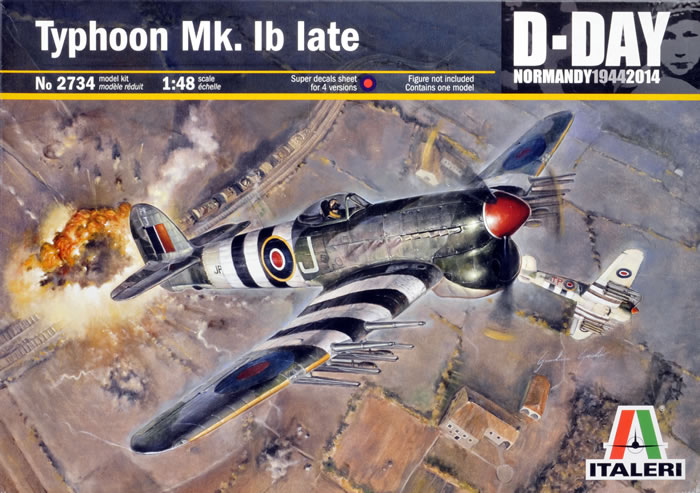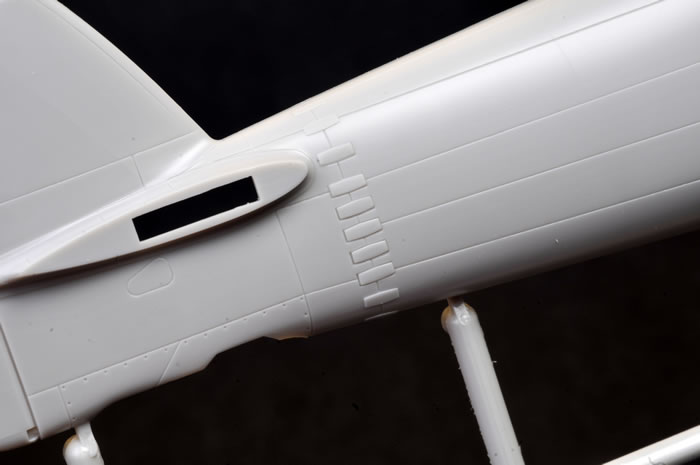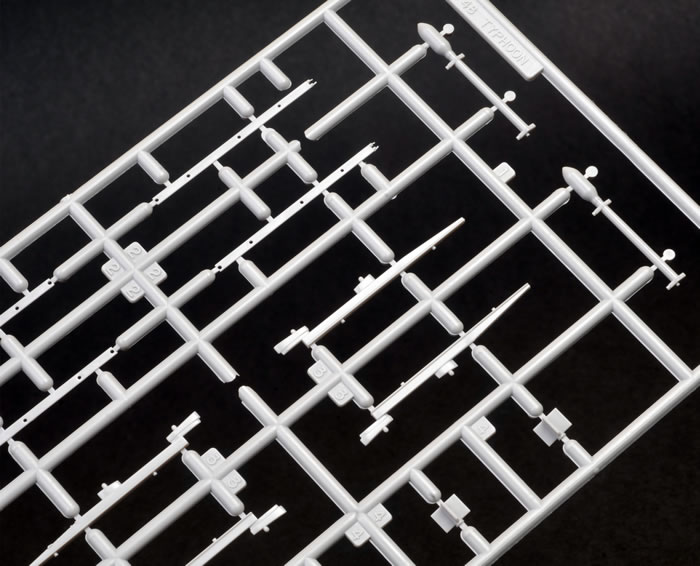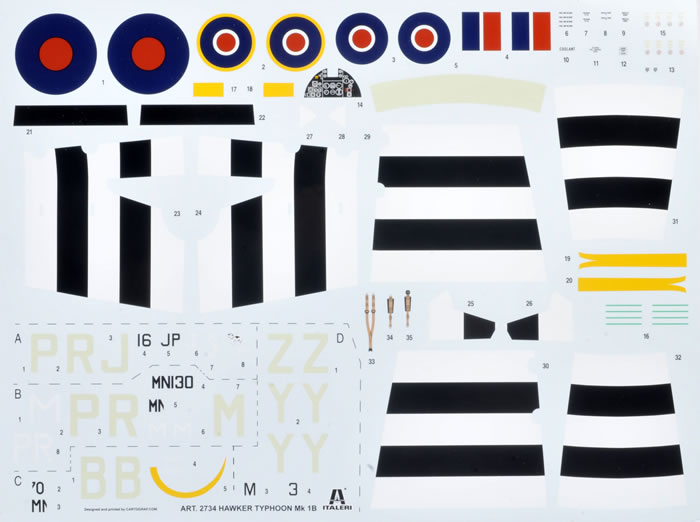|
Hawker Typhoon Mk.IB Late

Italeri, 1/48 scale
S
u m m a r y |
| Catalogue Number: |
Italeri Kit No. 2734 - Hawker Typhoon Mk.IB Late |
| Scale: |
1/48 |
| Contents and Media: |
107 parts in light grey plastic; nine parts in clear; markings for four aircraft on one decal sheet. |
| Price: |
USD$44.65 available online from Squadron
GBP £24.99 plus shipping available online from Hannants |
| Review Type: |
FirstLook |
| Advantages: |
Well moulded; crisp fine recessed surface detail; good levels of detail throughout; high-quality glossy Cartograf decals; a welcome re-release. |
| Disadvantages: |
Fit problems around upper fuselage insert. |
| Conclusion: |
It is pleasing to see that Italeri has made this kit available again, as it has been hard to find in its original boxing in recent years. The relatively small parts count makes it appropriate for even a beginner modeller, with only the poorly fitting fuselage inserts complicating the build. |
Reviewed by Brett Green

Italeri's 1/48 scale Typhoon Mk.IB Late is available online from Squadron.com
Hawker Aircraft was formed in 1920 and delivered a number of classic fighter and bomber designs for the RAF in the inter-war period. These included the Nimrod, the Fury, Audax and Demon – all biplanes with fixed-pitch wooden propellers and non-retractable undercarriage.
In 1935, Hawker Aircraft designed the first low-wing monoplane fighter to see service with the RAF – the Hawker Hurricane. Although the Hurricane was undoubtedly a great leap forward compared to Hawker’s previous biplane fighters, it retained many of that earlier generations’ characteristics including box girder fuselage structure and fabric-covered formers and stringers. The earliest Hurricanes were even still fitted with two-bladed fixed pitch propellers and fabric covered wings.
Hawkers were considering a more modern replacement for the Hurricane as early as 1937. Planned as a medium-altitude interceptor, the Hawker Typhoon was powered by the 24 cylinder H-block Napier-Sabre engine and featured a thick inverted gull wing. The Typhoon was expected to achieve a top speed of 460 mph, but the drag induced by its thick wing limited this to just over 400 mph. Climb rate and general performance above 20,000 feet failed to meet expectations too.

As if these shortcomings were not bad enough, the big Napier-Sabre engine was prone to catch fire as it started; and a number of early Typhoons suffered from catastrophic airframe failure when the entire tail unit separated from the fuselage in flight. The former problem was addressed by having ground crew with a fire extinguisher standing by when the Typhoon was running up; and the tail was reinforced with a series of fish-scale plates on the rear fuselage.
These problems were not ironed out until 1942, at which time the Typhoon was switched from interceptor to ground attack duties. It was in this role that the Typhoon excelled.
The good low altitude performance and heavy load capacity of the Typhoon meant that it could carry two 1,000 lb bombs to targets on the continent. From September 1943, the Typhoon would be equipped with eight 60 lb RP-3 rockets, which were used to devastating effect against ground targets until the end of the war.
The Hawker Typhoon was constantly improved over its period of wartime service. The initial “car door” canopy offered only limited rearward vision so this was eventually replaced with a clear-vision sliding bubble canopy. The original three-bladed propeller was upgraded to a four-bladed unit to make the most of the powerful Napier-Sabre engine. Later Typhoons were also retrofitted with the larger horizontal tailplanes of the Hawker Tempest.
By pilot accounts, the Typhoon was a solid gun platform, fast at low altitudes and impressively powerful, although controls were heavy at high speed.
Although it proved unsuitable as a pure fighter, the Typhoon lives on in legend thanks to its remarkable ground attack record against Axis airfields, shipping, vehicles and trains.
Hasegawa released several 1:48 scale versions of the Hawker Typhoon, starting with the Car Door ‘Early Version’ in early 1999 and followed up with the bubbletop some time later.
Italeri has now reboxed the bubbletop kit with new decals.
This kit comprises 107 parts in medium grey coloured plastic, nine parts in clear and markings for four aircraft.
The model is very accurate in terms of outline and detail.
Surface detail stands up well even by today’s highest standards with fine, crisp and consistent recessed panel lines plus selected rivet lines and fasteners. The empennage features the reinforcing "fishplates" moulded in place.

The clear canopy is supplied with a separate windscreen, so it may be posed open or closed.
The box top describes this as a late version, but I suppose it depends of your definition of "Late". The kit best represents an early bubbletop, with only the smaller Typhoon tail surfaces and a three-bladed propeller supplied.
Eight rockets and three styles of Hispano 20mm cannon barrels (two uncovered and one covered) are included.

Both shrouded and unshrouded exhausts are offered too, so you'll have some goodies for the spares box.
Cockpit detail is adequate straight from the box, with the typical “bottomless” floor well represented. The wheel wells are boxed in and feature raised structural detail and some plumbing moulded in place.

Hasegawa started making the most of their mouldings during the 1990s by tooling parts with separate inserts to permit multiple versions of a particular aircraft.
While I am sure that this approach will be applauded by accountants everywhere, it does have its disadvantages.
The first problem is that join seams do not always coincide with natural panel lines, meaning that some filling, sanding and rescribing may be necessary.
The second issue is that fit is sometimes awful.
This kit features inserts in each upper mid fuselage area to accommodate the bubbletop configuration. In the earlier release, a different set of fuselage inserts for the car door version was included.
Last time I built one of these kits, forearmed with the knowledge of potential fit problems, I started construction by gluing the inserts into each fuselage side. I worked on each side separately as this allowed me to align the curved edges of the inserts with the contours of the fuselage sides. It would be much easier to deal with a gap along the top of the fuselage than to fill, recontour and sand the fuselage sides.
As it turned out, I was able to line up the inserts and the fuselage sides pretty well, although there would be a few stray join seams to clean up later.
However, test fitting the fuselage halves exposed the real problem. There was a prominent gap of between 1 and 2 mm on the top fuselage centreline between the inserts. This gap would need some serious attention further down the track. Even so, dealing with this gap is much easier than coping with a large step on each fuselage side.
Markings
Italeri has an all-new decal sheet with markings for four aircraft. All four are finished in the ubiquitous Ocean Grey and Dark Green upper surfaces with Medium Sea Grey below; and all are represented on 6 June 1944 and therefore carry full invasion stripes.
Colours are called out as F.S. numbers and Italeri acrylic paints only.

The decal sheet is printed by Cartograf. It is glossy and printed in perfect register - a definite improvement over the original Hasegawa decals.
It is pleasing to see that Italeri has made this kit available again, as it has been hard to find in its original boxing in recent years.
Despite the moulds being first released more than 15 years ago, they still holds up very well by today’s standards. The relatively small parts count makes it appropriate for even a beginner modeller, with only the poorly fitting fuselage inserts complicating the build.
If you like more of a challenge, there are plenty of aftermarket accessories and markings out there. I can highly recommend the Barracuda Studios cockpit, wheels, exhausts and intakes. They lift this model to a different level.
Thanks to The Hobby Company Limited for the sample.
Review Text and Images Copyright © 2015 by Brett Green
Page Created 28 January, 2015
Last updated
29 January, 2015
Back to HyperScale Main Page
Back to Reviews Page |
